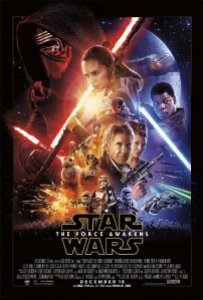 I was 9 years old when “Star Wars Episode I: The Phantom Menace” was released, and despite all the bile hurled at the prequels, at that age I had no concept of good. All I knew was that there was more. More Star Wars was a good thing, and for the Millennials like me who give the prequels the most hatred, “Star Wars Episode VII: The Force Awakens” is the first Star Wars movie we’ve been able to see for the first time as adults.
I was 9 years old when “Star Wars Episode I: The Phantom Menace” was released, and despite all the bile hurled at the prequels, at that age I had no concept of good. All I knew was that there was more. More Star Wars was a good thing, and for the Millennials like me who give the prequels the most hatred, “Star Wars Episode VII: The Force Awakens” is the first Star Wars movie we’ve been able to see for the first time as adults.
“The Force Awakens” doesn’t need to be as great as “A New Hope” or “The Empire Strikes Back” for it to live up to expectations. It needs to be able to fit snugly into the Star Wars canon in a way the prequels never seemed to belong. J.J. Abrams has delivered less than a masterpiece, but “The Force Awakens” is a Star Wars movie.
“The Force Awakens” has the spectacle, the whimsy, the humor, the campy, screwball charm, the romance and the invigorating excitement of the original three films. In channeling the same themes of good and evil and the mythos of the Force, this film has the spirit of a Star Wars classic.
In part, it’s because J.J. Abrams has nearly remade “Star Wars Episode IV: A New Hope.” In between films, a new evil entity known as The First Order has risen to power. Luke Skywalker (Mark Hamill) has vanished, and Kylo Ren (Adam Driver) is the dark lord out to find him and put an end to the rise of the Jedi. A Resistance pilot named Poe Dameron (Oscar Isaac) hides a map to Luke’s location in a droid called BB-8 and sends it off on a desert planet. The person who finds it is another scavenger, a person without a family and with dreams of becoming a pilot and getting out of this desolate place. Starting to sound familiar? The only difference is that this young person is a woman, Rey (newcomer Daisy Ridley). Along the way a Stormtrooper named Finn (John Boyega) will break off from The First Order and even stage a daring, hapless rescue of Poe before meeting Rey, working to protect her and banish his own past demons.
Though “A New Hope” is proud to boast themes of good and evil in the biggest and broadest of space opera, it is a film about growth, finding identity and believing in yourself. Luke makes that spiritual journey and sheds his youthful naiveté, and Rey will go on that same journey, answering the call to believe in the Force and embrace her destiny.
This is what Star Wars is about, and in that spirit Abrams more than delivers. As with the best of the franchise, the film dances between different moments of action on the ground and in the air. There are thrilling lightsaber duels, stunning dogfights, goofy chases and escapes from an amorphous tentacled creature, a scene inside a seedy cantina full of quirky galactic beings, and even something of a new Death Star. Despite the high CGI gloss, Abrams has captured the tempo of these pictures as much as the tone, with cathartic, cheerful action set pieces that avoid chaos and over-stylization in a way that’s classical and tangible.
John Boyega has a lot of uncontained enthusiasm as Finn, Adam Driver has a lot of angsty rage as Kylo Ren, and Daisy Ridley has a lot of scruffy, rugged charm and star power. Yet all three are led by the master, back in character as though he never left: Harrison Ford as Han Solo. Han is one of the great pop culture characters of all time, and he continues to get the best lines, and Chewbacca the best reaction shots. Ford is acting from the seat of his pants, sarcastic and cool yet always in a hurry and thinking on the fly. Finn has brought Han to the new Death Star and reveals he has no plan for taking down its shields, but maybe they can use the Force. “That’s not how the Force works,” Han bellows in his trademark exasperation. This could be Ford’s best performance in nearly two decades.
“The Force Awakens” does at times feel like a reboot, but hearing John Williams’s magical score swell in all the right places reminds us that there’s no harm in not reinventing the wheel. And the film does take one massive risk that will surely be polarizing. But regardless of if the plot has holes or if the twists hold up, this is still Star Wars. More is good.
4 stars

